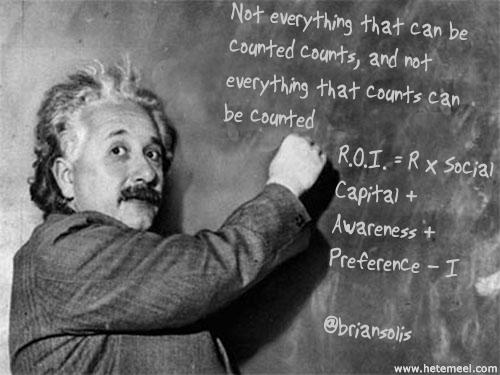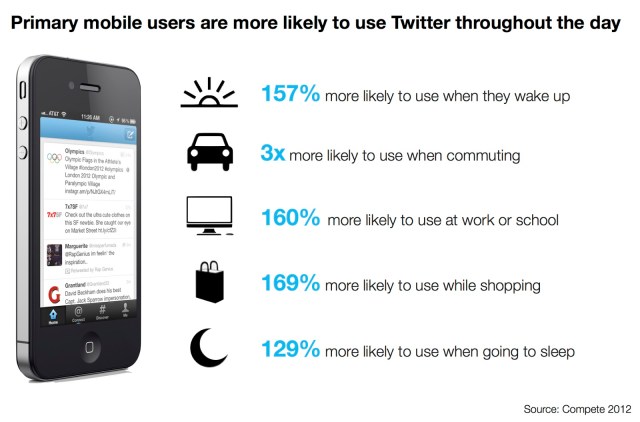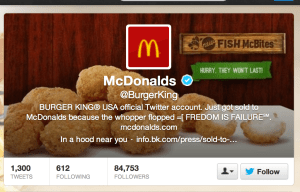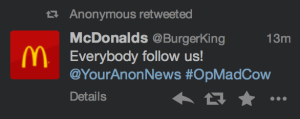 Guest Post by Jaap Favier, managing partner of The Small Circle
Guest Post by Jaap Favier, managing partner of The Small Circle
What is the secret of bars? Why do we happily pay four times as much
for beer in a bar as in a store? We pay this brand premium to be with
friends. The secret of bars is that they convert our quality time into
cash. Like bars, social media are places where friends meet. The best
social media programs also convert the consumer’s social time into a
brand premium, reaching a return on investment (
ROI) up to four times as high as the ROI of a TV commercial.
The time with friends and relatives is worth a lot to us. It’s worth
our paycheck. A close look at the average bar tab or restaurant
check—even the costs of a family holiday or yacht—reveals that we spend
what we earn per working hour for an hour of time with friends.
Pew Research
data confirms this remarkable fact: an extra hour per week with friends
makes consumers just as happy as an extra hour’s worth of salary. It
makes sense: if we valued a working hour more than an hour with our
buddies, we wouldn’t go to happy hour but stay at the office. Branded
blogs, Facebook fan pages, YouTube channels,
Twitter accounts, and Pinterest boards serve as online bars, where:
Staff speaks to visitors.
Marketers promote the brand, just like waiters in a bar do. Some of the
fans and followers listen but rarely pass the commercial messages along.
As a result, the stream of service messages and sales promotions on
sites like the JetBlue Twitter account offers the airline’s 1.7 million
followers hardly any quality time.
Strangers introduce themselves.
Bloggers, tweeters, and vloggers use branded content to make a good
impression on the strangers and acquaintances that come to their online
venue. Some of the readers start a dialogue, and when it clicks, the
blogger and engaged reader will often agree to meet face-to-face,
according to a study by
Technorati.
Friends converse with each other.
Consumers pick up branded content and “like” and share it with friends.
Some comment and chat, often with close friends. TOMS Shoes, for one,
feeds these dialogues on its Facebook page. The shoe brand gives one
pair of shoes to children in third-world countries for every pair it
sells. With daily footage of delighted children and articles about
poverty, the brand gives fans food for thought and conversation.
A consumer, let’s call her Lucy, walks into a bar wearing her TOMS.
The label on her shoes tells everyone what she stands for. She sits down
with a friend, sharing the story of the brand’s benevolence. The TOMS
label is a social signal in the offline bar. In online bars, fans and
followers give the same social signals when they “like,” comment, share,
retweet, and repin a brand. “Likes” are the new logos. When Lucy clicks
on “Like” and comments “I love my new toms” on the brand’s fan page,
she is telling her friends, neighbors, and colleagues who she is, what
she stands for, and where she belongs.
Lucy’s contacts see her online signals. An acquaintance will take
note, a friend may click on “Like” herself, and a close friend or
relative may add a comment: “They look so good on you, Luz ☺” Lucy’s
signals and the responses are directed at consumers, not at TOMS Shoes.
But TOMS benefits big time from these peer interactions. A
sociological study
by the Rotterdam School of Management shows that after seeing Lucy’s
signal, 7% of her acquaintances will consider the brand, and 42% of her
close friends will want to own a pair too. Compare that to the mere 5%
of consumers who get interested after they see a TV commercial: due to
social interactions, consumers make an 840% leap of faith into the
brand!
Each time Lucy and a friend share a brand experience, they invest
time and trust. Each touchpoint between consumers represents value to
the brand. That value is positive or negative, depending on the
sentiment the two consumers exchange: a friend bashing the brand cancels
out two “likes” by other friends. Either way, that value means money,
because time is money for both consumers. Just like in offline bars,
that value represents the brand premium both consumers are willing to
pay. Add up the value of the thousands or millions of touchpoints
between friends, acquaintances, and strangers in a social media program
and you get the total brand premium that consumers are collectively
willing to pay. By definition, this collective premium is the rise in
brand equity: the return on investment of the social media program.
At the end of a successful evening, a bar owner keeps track of his
ROI with hundreds of bar tabs. You as social marketer can do the same.
To calculate the financial success of your social media program, you
simply need to keep tab on the five factors that define the program’s
ROI:
Number of touchpoints.
Count every time a branded YouTube video was downloaded, every “Like”,
and every view of the company blog, every visit to the discussion forum.
You don’t know how many fans saw your Facebook post or tweet? Thanks to
research by people like Dan Zarella, marketers can make a pretty sound
assessment of how many friends and followers digest their content and
pass it along by tracking the likes-per-fan and retweet ratios.
Time.
Every tweet, retweet, post, comment, online video, pin, and repin takes a
few seconds both to produce and digest. Deciding to click on “Like”
takes the average consumer for instance seven seconds. In Facebook, an
average eight close friends and twenty-six other friends will
subsequently take five seconds to digest that “Like.”
Trust.
Look at the intensity of the online interactions between consumers to
assess how close they are. A good metric for intimacy is the
comment-to-like ratios of Facebook fan posts: the higher these ratios,
the more close friends shared the brand experience. On Twitter, the
retweet-to-tweet ratio is a solid indicator.
Sentiment.
Measure the shared sentiment between consumers by sifting through the
comments and retweets. Companies like Radian6 offer natural language
processing tools that automate this analysis for marketers. The word
graph produced during such an analysis also serves to double-check the
trust factor. Friends use words like “fun” in their exchanges, while
close friends may use words like “moving” and “emotional.”
Income.
Social marketers know the demographics of their fans and followers,
including the net income of senders and receivers of their content.
In social media, the time and trust between consumers boosts the
effect on brands. Compare that to a consumer watching a Super Bowl ad:
he receives a 30-second message from a marketer with a trust factor of
1. According to
Nielsen,
33% of the 100-million odd viewers like the average Super Bowl
commercial. Their average net income is $35,500 per year, or $0.21 per
minute. All these viewers collectively invest:
The $3.5M return on investment isn’t a bad deal, since the going
Super Bowl rate is $3.3M. The Small Circle has turned this formula into a
ROI model that brands can use for any social media campaign or program.
To test its validity, we applied the model to more than 50
well-documented social media campaigns and programs. A selection of the
test results is shown below. Benchmarking the ROI of social media with
the returns of a Super Bowl ad shows that:
1. The ROI of social media is up to four times as high as TV
commercials. Consumers pass the branded content along and add trust
every time they do.
2. Both large and small campaigns and programs can achieve high
returns. The closer the senders and receivers of branded content are,
the higher the impact on the brand.
3. In the most successful campaigns, consumers do the talking.
Marketers don’t have the time to chat with every fan and consumers
prefer to talk with each other anyway.
You are more than welcome to use this tried-and-tested interactive
model to verify the ROI of your brand’s fan page, Twitter account, email
campaign, Pinterest Board, or other social media activities. Download
the model and find out how much money your social media campaign or program is making your company.
Bar owners collect their ROI from the till every night. Social
marketers have a harder time converting consumer conversations into
sales. Analyst Susan Etlinger from
Altimeter Group shows
that 70% of them don’t know how social media connects to revenues. To
find out, she advices marketers to measure the route consumers take from
social media to purchase with:
Tags and links.
How many followers clicked on the Bit.ly link in the tweet? How many readers followed the hotlink in the company blog post?
Platform apps and services.
Did the user of our mobile app scan our product in the store? How many non-fans read our post according to Facebook analytics?
Correlation analysis and A/B testing.
Do peaks in sales follow surges of “likes”? Do fans and followers behave differently than other customers?
Without answers to these questions, the ROI of social media is just a
number. With the answers, that number becomes a valuable benchmark to
measure your performance against the best-in-class campaigns. You
uncover which investments will bring social marketing to the next level.
You connect the dots and deliver the number.
Article courtesy of Brian Solis: http://ow.ly/hxHfo





















